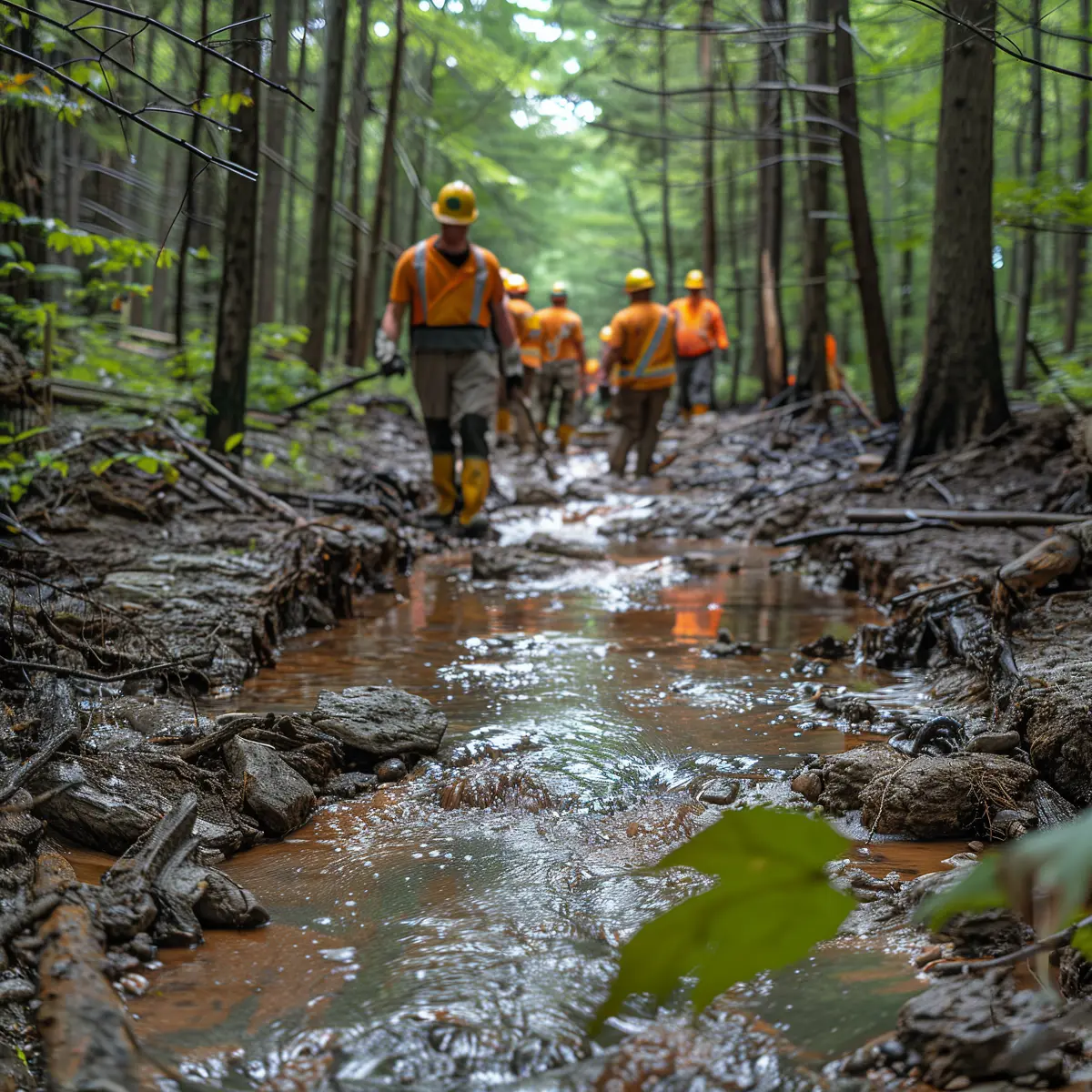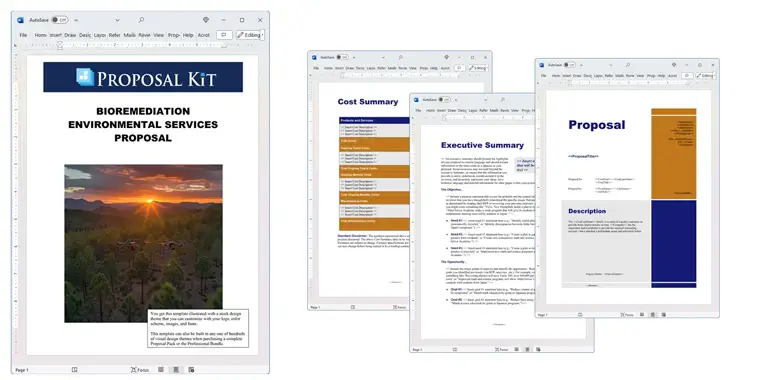How to write your Bioremediation Environmental Services Proposal
We include this 14 page layout with every Proposal Pack. If you want this template to have a different visual design theme than the one illustrated here, purchase any Proposal Pack design and create this template using the purchased design theme. This template is included in every Proposal Pack. If you get a Proposal Pack or the Professional, you can also make any variation of this template with different chapters to suit your needs.
We typically include more chapters in the templates than most people will need to give everyone more variety in the chapters they may need. You can trim down a long template by removing pages you do not need or combining multiple chapter topics into one page.
 DOWNLOADABLE, ONE-TIME COST, NO SUBSCRIPTION FEES
DOWNLOADABLE, ONE-TIME COST, NO SUBSCRIPTION FEES If you need only this template pre-assembled on DVD media order from our Amazon shop.
If you need only this template pre-assembled on DVD media order from our Amazon shop.
You can also create countless variations of this document to suit your needs using the included library of 2200+ chapters if ordering a Proposal Pack or Professional.
 What Our Clients Say
What Our Clients SayI have used it to prepare many documents in my business. The templates and advise assist the business owner as myself to develop the correct documents necessary for my business functions."
DG Business Solutions Inc.
Related Article
Related Video
Related Templates
- Natural Resources Management Proposal
- Environmental Cleanup Proposal
- Waste Removal and Cleanup Services
- EPA Federal Government Grant Proposal
- EPA Federal Government Grant Proposal #2
- Disaster Cleanup Services
- Environmental Program Proposal
- Climate Change Research Proposal
Writing Compelling Proposals for Bioremediation Environmental Services Using Proposal Kit
In the specialized field of bioremediation environmental services, writing a detailed and convincing proposal is crucial for businesses aiming to offer sustainability solutions, consulting, and training. This article explores how companies, regardless of their size or sector, can leverage the Proposal Kit's comprehensive template library and Wizard software program to create effective proposals and reports.
Can you see yourself needing to draft a detailed and persuasive bioremediation environmental services proposal, perhaps feeling overwhelmed by where to begin?
How to Write a Bioremediation Environmental Services Proposal
For a person new to proposal writing, the best approach to creating a bioremediation environmental services proposal is utilizing the Proposal Kit. This kit simplifies the process by providing a library of customizable templates and an intuitive Wizard software program. The software also includes a line item quoting database system, essential for accurately detailing cost summaries, quotes, estimates, budgets, and other financial aspects of a proposal.
What Types of Projects Are Bioremediation Environmental Services Proposals Written For?
Bioremediation environmental services encompass a variety of projects, such as:
- Cleanup of oil spills in aquatic and terrestrial environments.
- Remediation of contaminated soil and groundwater.
- Restoration of industrial sites to natural conditions.
- Treatment of wastewater using bioremediation techniques.
- Management of agricultural runoff to prevent water pollution.
- Bioremediation in urban settings for improved air quality.
- Sustainable waste management using biological methods.
- Consulting services for environmental impact assessments.
- Training programs in bioremediation techniques and practices.
- Research and development in advanced bioremediation technologies.
Each of these topics plays a significant role in constructing a comprehensive, persuasive bioremediation environmental services proposal. Using the Proposal Kit, these sections can be effectively addressed, ensuring that the proposal is not only professional and thorough but also resonates with the needs and values of potential clients or funders.
Chapters this template is built with
In a bioremediation proposal, many Proposal Kit templates are particularly useful. These are just a small selection of the thousands of chapter templates available in the Proposal Kit library for you to include in your own customized proposal:
Cover Letter
The Cover Letter is the introductory piece of your Bioremediation Environmental Services Proposal. It should briefly introduce your company, explain the purpose of the proposal, and highlight your commitment to providing effective bioremediation solutions. The cover letter sets the tone for the proposal, establishing a professional and personal connection with the recipient. It should mention critical points such as your field experience, understanding the client's needs, and readiness to deliver top-notch services.
Executive Summary
The Executive Summary provides a high-level overview of the entire proposal. This section should succinctly summarize the project's main objectives, proposed solutions, and anticipated outcomes. It serves to give decision-makers a quick snapshot of your company's value. Highlighting key aspects like innovative techniques, project timelines, and expected benefits can help secure the client's interest from the outset.
Natural Resources
The Natural Resources chapter details how your bioremediation services will help protect and restore natural resources. Explain the types of contaminants present, their impact on the environment, and your strategy for remediation. This section should demonstrate your understanding of the environmental challenges and ability to implement effective, science-based solutions.
Sustainability
The Sustainability chapter outlines your commitment to environmentally sustainable practices. Describe the methods and technologies you use to ensure that your bioremediation processes minimize environmental impact. Highlighting your focus on long-term environmental health, resource conservation, and eco-friendly practices can reassure the client of your dedication to sustainability.
Stewardship
Stewardship involves the responsible management and care of the environment. This section explains how your company practices environmental stewardship through bioremediation projects. Detail any partnerships with environmental organizations, adherence to regulations, and ongoing monitoring efforts. This chapter should convey your commitment to maintaining the health of the ecosystems you work in.
Services Provided
The Services Provided chapter should offer a comprehensive overview of your specific bioremediation services. Describe your soil, water, and air remediation techniques, the types of projects you handle, and any specialized services you provide. Use this section to emphasize your expertise and the breadth of your service offerings, ensuring potential clients understand the full range of your capabilities.
Training
In the Training chapter, describe the training programs you offer to ensure that all personnel are well-equipped to perform their duties safely and effectively. Detail the types of training provided, such as safety protocols, technical skills, and environmental regulations. This section should highlight your commitment to maintaining a knowledgeable and competent workforce, which is crucial for successful bioremediation projects.
Consulting
The Consulting chapter focuses on your advisory services. Explain how you assist clients in planning and managing bioremediation projects. Detail your approach to site assessments, regulatory compliance, project management, and ongoing support. Emphasize your role as a trusted advisor who can guide clients through complex environmental challenges.
Cost Summary
The Cost Summary provides a detailed breakdown of the financial aspects of your proposed services. Include estimates for each project phase, from initial assessments to final remediation efforts. Clearly outline any potential additional costs and justify the pricing with references to industry standards and the quality of services provided. This section should help clients understand the value they will receive for their investment.
Credentials
The Credentials chapter should showcase your company's qualifications, certifications, and experience in bioremediation. Include information about your team's expertise, relevant project successes, and industry accolades. This section is critical for establishing credibility and reassuring clients that you have the necessary skills and experience to handle their projects.
About Us
The About Us chapter provides an opportunity to tell your company's story. Include background information, your mission and vision, key milestones, and any unique aspects of your business. This section should convey your company's identity, values, and commitment to environmental stewardship, helping to build a personal connection with the client.
Use cases for this template
Isabella's Initiative
Isabella, at the helm of the non-profit organization Green Canopy Network, was faced with the challenge of drafting a proposal for a unique deforestation remediation project using drones for aerial seedling drops.
Confronted with the task of proposal writing, Isabella turned to the Proposal Kit, known for its comprehensive structure and ease of use. As a leader passionate about environmental conservation, she sought a tool that would help her effectively communicate her vision for a large-scale reforestation project.
Isabella began with the Executive Summary template, clearly articulating the project's aim to replant trees in deforested areas using drone technology. This innovative approach required a detailed explanation, which she skillfully provided, emphasizing both the urgency and the innovative nature of the project. In the Cost Summary section, she meticulously outlined the financial requirements, including the costs of drones, seedlings, and operational expenses. The Sustainability template was instrumental in showcasing the long-term environmental benefits of the project, such as increased biodiversity, restoration of natural habitats, and the combatting of climate change effects.
Recognizing the need for skilled operation of drone technology and ecological knowledge, Isabella utilized the Training template to describe the comprehensive training program for her team. This included drone operation, ecological monitoring, and data analysis to ensure effective reforestation. The Stewardship section underscored her organization's commitment to ethical environmental practices and long-term care of the reforested areas. Her proposal, marked by its clarity, innovation, and thoroughness, succeeded in securing the necessary funding and support, setting a precedent for technological integration in environmental restoration efforts.
David's Deadline
David, an employee at Global GreenTech Inc., was tasked with creating a proposal for a large-scale wastewater treatment project in a short timeframe.
The tight deadline was David's primary concern. He turned to Proposal Kit for its efficiency.
Utilizing the Wizard software, he quickly assembled the necessary templates, focusing on Natural Resources and Consulting to highlight the project's scope and his company's expertise.
The integrated financial tools helped him promptly complete the Cost Summary. His timely and professional proposal was well-received, showcasing the effectiveness of Proposal Kit in a high-pressure scenario.
Sophia's Mission
Sophia, a volunteer at EarthCare International, needed to create an RFP for a bioremediation research project.
Sophia found the Proposal Kit's structured approach ideal for drafting a clear and comprehensive RFP. She used the Sustainability and Training templates to articulate the project's long-term goals and the training involved.
The Cost Summary and Consulting sections were pivotal in outlining the project's financial and expertise needs. The Proposal Kit enabled her to create an RFP that was both detailed and appealing.
The response to her RFP was enthusiastic, demonstrating how the Proposal Kit facilitates effective communication in diverse proposal scenarios.
Conclusions and Recommendations
In conclusion, whether you are a small business owner, a corporate employee, or a non-profit volunteer, the Proposal Kit is an invaluable tool for creating bioremediation environmental services proposals. It simplifies the process of assembling a custom proposal document letting you focus on your message and not the nuts and bolts of putting together a complex document.
Also Known As
This template may also be referred to in different ways or be used in more specialized situations, such as:
- Ecological Restoration and Pollution Cleanup Proposal
- Environmental Cleanup and Biorepair Services Proposal
- Bio-based Pollution Remediation Plan
- Sustainable Environmental Recovery Services Proposal
- Organic Waste Remediation and Restoration Proposal
- Eco-friendly Contaminant Removal Plan
- Biological Hazard Mitigation Services Proposal
- Natural Resource Renewal and Management Proposal
- Bio-Enhanced Environmental Cleanup Project Proposal
- Green Technology Remediation Services Plan
Abstract
 In the field of bioremediation environmental services, writing a proposal is crucial for businesses seeking to provide solutions for cleaning up contaminated soils and enhancing water quality. Bioremediation harnesses the natural ability of microbes and plants to break down hazardous waste using organic compounds and natural processes. The Proposal Kit aids companies by offering customizable templates and user-friendly Wizard software, streamlining the process of proposal creation. This toolkit helps detail everything from project objectives to cost summaries, making it a viable option for various cleanup efforts, including oil spill remediation and wastewater treatment.
In the field of bioremediation environmental services, writing a proposal is crucial for businesses seeking to provide solutions for cleaning up contaminated soils and enhancing water quality. Bioremediation harnesses the natural ability of microbes and plants to break down hazardous waste using organic compounds and natural processes. The Proposal Kit aids companies by offering customizable templates and user-friendly Wizard software, streamlining the process of proposal creation. This toolkit helps detail everything from project objectives to cost summaries, making it a viable option for various cleanup efforts, including oil spill remediation and wastewater treatment.
Bioremediation employs a variety of methods, such as in situ bioremediation, where natural processes occur directly in the contaminated area, using the surrounding environment's natural ability to degrade pollutants. This technique often involves different types of microorganisms, including bacteria and fungi, which produce enzymes to break down hydrocarbons and other pollutants. For example, bioreactors can be used to control and enhance the growth of these organisms, optimizing conditions such as temperature and oxygen availability. These systems are often part of larger cleanup efforts coordinated by researchers and backed by the National Research Council or similar bodies.
Implementing bioremediation involves understanding the specific type of pollutant and the land's characteristics. For instance, nitrogen and other nutrients may be added to stimulate microbial activity in contaminated soils. Factors such as the presence of perchlorate or petroleum compounds require targeted approaches, often involving a combination of physical and chemical methods. The first step is a thorough site evaluation, which is developing a strategy to deal with pollutants. Testing and overseeing the project ensure that the bioremediation process achieves its goals, ultimately restoring the environment to a healthier state.
 Overall, bioremediation environmental services offer a sustainable and effective solution for pollution cleanup, with the potential to purify ecosystems through the natural processes of microbes, plants, and other organisms. By employing various bioremediation techniques and using the Proposal Kit, businesses can communicate their capabilities and commitment to environmental stewardship, ensuring compliance with regulations while contributing to a cleaner world.
Overall, bioremediation environmental services offer a sustainable and effective solution for pollution cleanup, with the potential to purify ecosystems through the natural processes of microbes, plants, and other organisms. By employing various bioremediation techniques and using the Proposal Kit, businesses can communicate their capabilities and commitment to environmental stewardship, ensuring compliance with regulations while contributing to a cleaner world.
Bioremediation environmental services play a major role in addressing pollution through innovative and sustainable methods. By using the natural processes of microorganisms like bacteria, fungi, and plants, these services transform hazardous waste into harmless substances, aiding in the restoration of contaminated sites. Specifically, in situ bioremediation is a practical method where microbes interact directly with pollutants in the soil or groundwater, minimizing the need for complex physical interventions. This approach often involves optimizing conditions such as nutrient availability, carbon and nitrogen levels, and temperature to enhance microbial activity and pollutant breakdown.
Research, including insights from the National Research Council and the National Academies, supports the development of advanced bioremediation techniques. These methods include using bioreactors to control environmental variables and improve microbial efficiency. Such systems can carry out the bioremediation process more by regulating topics like oxygen levels and energy inputs, ensuring the survival and growth of beneficial microbial species. This controlled environment allows for the production of enzymes capable of degrading complex organic compounds, such as hydrocarbons, into simpler, non-toxic molecules.
 The bioremediation process also considers other factors, such as the presence and types of organic compounds and their interaction with microbes. For example, perchlorate and petroleum compounds may require specific bioremediation strategies due to their chemical properties. Techniques like the use of mulch or additional nutrients can aid in the breakdown of these pollutants, showcasing the versatility of bioremediation as a solution. The capability of plants to act as natural purifiers through phytoremediation further enhances the process, with their roots providing a habitat for microorganisms and facilitating the movement and uptake of pollutants.
The bioremediation process also considers other factors, such as the presence and types of organic compounds and their interaction with microbes. For example, perchlorate and petroleum compounds may require specific bioremediation strategies due to their chemical properties. Techniques like the use of mulch or additional nutrients can aid in the breakdown of these pollutants, showcasing the versatility of bioremediation as a solution. The capability of plants to act as natural purifiers through phytoremediation further enhances the process, with their roots providing a habitat for microorganisms and facilitating the movement and uptake of pollutants.
To ensure successful implementation, bioremediation projects involve meticulous planning and evaluation. Initial experiments and testing phases help in understanding site-specific conditions and the selection of suitable species and methods. The coordination and oversight of these projects by skilled researchers and professionals ensure that bioremediation efforts remain on track, adapting to any challenges that may arise. By discussing examples of past successes and assessing the feasibility of proposed solutions, these projects establish confidence in bioremediation as a viable option for environmental recovery.
Ultimately, bioremediation offers a multitude of possibilities for addressing pollution while promoting sustainability. By understanding the intricacies of the bioremediation process and using tools like the Proposal Kit, companies can communicate their strategies and demonstrate their commitment to ecological restoration and environmental stewardship. This comprehensive approach not only helps in cleaning up contaminated sites but also contributes significantly to improving overall water quality and the health of ecosystems worldwide.
Frequently Asked Questions
What should be included in a bioremediation environmental services proposal?
A comprehensive bioremediation proposal should include an introduction to the problem, objectives of the project, a detailed methodology outlining the bioremediation techniques to be employed, an assessment of the site's current environmental condition, projected timelines, cost estimates, and a plan for monitoring and evaluating the success of the bioremediation efforts. Additionally, it should include the team's qualifications, regulatory compliance considerations, and contingency plans for potential challenges.
How do I determine the appropriate bioremediation methods for my project?
The selection of bioremediation methods depends on several factors, including the type and extent of contamination, site characteristics (such as soil type and hydrology), local environmental conditions, and regulatory requirements. It is often beneficial to start with a thorough site assessment and conduct small-scale feasibility studies or pilot tests. Consulting with experts in bioremediation and reviewing case studies of similar projects can also provide valuable insights into the most effective methods for your situation.
How can I ensure regulatory compliance in my bioremediation proposal?
Ensuring regulatory compliance involves understanding and adhering to federal, state, and local environmental regulations that pertain to site cleanup and bioremediation. This includes obtaining necessary permits, following guidelines for managing hazardous materials, and reporting progress as mandated by regulatory agencies. It's essential to consult with legal experts and regulatory authorities during the planning phase to ensure that all aspects of the proposal meet legal requirements and that the law will conduct the project.
What costs should I account for in my bioremediation proposal?
Cost considerations in a bioremediation proposal should encompass a wide range of expenses, including site assessment and analysis, procurement of bioremediation agents or materials, labor costs, equipment rental or purchase, transportation, regulatory fees, and expenses associated with monitoring and evaluation. Additionally, it's prudent to include a contingency budget to cover unexpected expenses or challenges that may arise during the project. A detailed and transparent budget can help secure funding and manage financial aspects effectively.
How do I demonstrate the effectiveness of the proposed bioremediation methods?
To demonstrate the effectiveness of the proposed bioremediation methods, you should include a robust monitoring and evaluation plan in your proposal. This plan should outline specific metrics and criteria for success, such as reductions in contaminant levels to meet regulatory standards. Include a timeline for periodic sampling and analysis, and describe the analytical methods. Providing data from previous successful projects or pilot studies can also strengthen the proposal by showing empirical evidence of the method's efficacy. Regular reporting and adaptive management strategies will help ensure the bioremediation efforts are on track and effective.
20% Off Discount
![]() Add To Cart This Word Template
Add To Cart This Word Template
 Add To Cart Proposal Pack for Any Business
Add To Cart Proposal Pack for Any Business
 Add To Cart Proposal Kit Professional
Add To Cart Proposal Kit Professional
 4.7 stars, based on 848 reviews
4.7 stars, based on 848 reviewsProposal Kit chapters used in this template
Cover Letter, Title Page, Table of Contents, Executive Summary, Natural Resources, Sustainability, Stewardship, Services Provided, Training, Consulting, Cost Summary, Credentials, About Us, Back Page
Line Item Automated Chapters
If you purchase a Proposal Pack or the Professional Bundle, these proposal pages are generated using an automated line-item database in the included Wizard software.
Cost Summary
You use this proposal for
- General business proposal
- Non-technical proposal
- Service sales proposal
- Project pitch proposal
- Non-government grant, non-profit, NGO proposal
- RFP response
- Nature, environmental proposal
How to create this template with Proposal Pack Wizard
You can create this document using any of the logo-designed Proposal Packs. Pick any Proposal Pack with a logo design theme you like best; they will all work equally well. The Proposal Pack for Any Business is the pack with no extra added logos or colors - designed to be used plain or for you to customize with your logos and graphics.
The Proposal Pack design theme you purchase will determine the visual look of this template. The screenshot above only shows the plain generic design theme.
We include a library of chapters to be assembled based on your needs. All proposals are different and have different needs and goals. We designed Proposal Pack so you can customize the documents to suit your needs.
You will best create this document using the Proposal Pack Wizard - Expert Edition software to select this template and build it in the Proposal Pack logo design theme of your choice along with any desired customizations (such as adding additional chapters, removing unneeded chapters, changing the order of chapters, and importing your company logo). This template outlines a proposal for the described situation. Each user is responsible for typing in the actual content of the provided pages with their information to complete the proposal. Suggestions in the abstract may include features in higher-end packages and are facilitated by the selection of chapter templates to support the narrative of each proposal, which help guide the user in filling in the details.
The Wizard software's AI Writer will write the content of the pages of the template based on details provided for your company, client, project, financial details and other writing instructions. This will provide a personalized version of the template completely written and ready to edit.
Once finished, the AI Writer's Word-to-PowerPoint converter can transform your proposal, business plan, or other business documents into a PowerPoint slideshow. Save time and effort by letting the AI analyze every chapter to condense its content into talking points, visually matching the document, and providing a consistent package of presentation material with the click of a button.
You create this template using the Wizard software with an entire Proposal Pack library and software. We include the Expert Edition of the software in the Proposal Kit Professional. Microsoft Word for Windows is required to use the customizing software. You can also edit Word document templates in other office software such as Word for Mac. We will assist Mac users in assembling complex templates for their first project if they do not have the required platform to run the Wizard software.
How to Build Templates Featured on Proposal Kit Website
Many people find the Proposal Kit website after searching for a specific proposal. Once you've purchased and installed the software, how do you build that template you found in the first place? This video shows you how to build any proposal you see on the Proposal Kit website.
 Ian Lauder has been helping businesses write their proposals and contracts for two decades. Ian is the owner and founder of Proposal Kit, one of the original sources of business proposal and contract software products started in 1997.
Ian Lauder has been helping businesses write their proposals and contracts for two decades. Ian is the owner and founder of Proposal Kit, one of the original sources of business proposal and contract software products started in 1997.By Ian Lauder
 Published by Proposal Kit, Inc.
Published by Proposal Kit, Inc.


 Cart
Cart
 Get 20% off ordering today:
Get 20% off ordering today: 


 Facebook
Facebook YouTube
YouTube Bluesky
Bluesky Search Site
Search Site